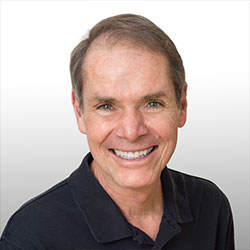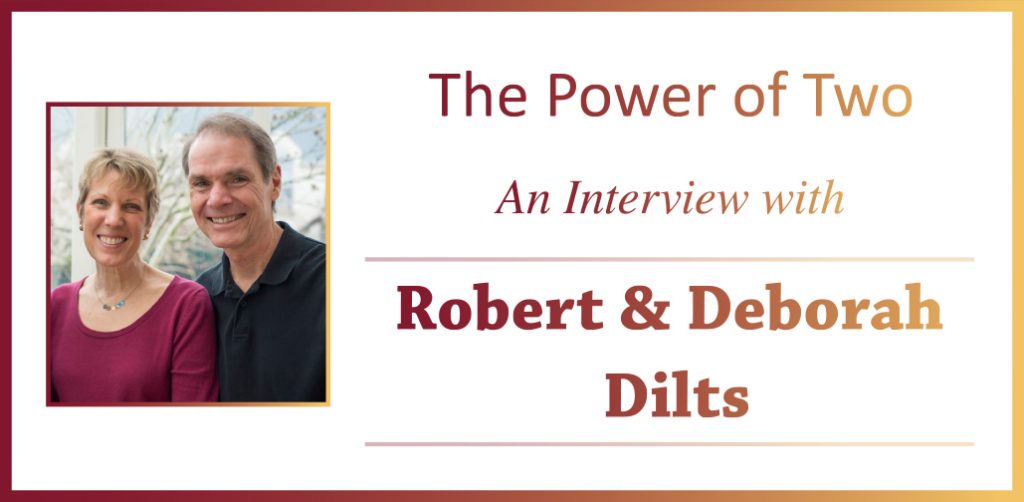The Power of Two: Robert Dilts and Deborah Bacon Dilts
By Marilia Baker
Lovers don’t finally meet somewhere. They’re in each other all along.
Rumi
 Since 1996, Robert Dilts and Deborah Bacon have worked together. Bacon recalls their meeting: “We met 20 years ago in Paris, when I was his interpreter. We continued working on stage together in France and Switzerland, once or twice a year for the following nine years. Then, almost exactly 11 years ago, we unexpectedly fell in love while working together in Paris. It was then that our ways of working together began to change.” This captivating couple has had a rewarding personal and professional partnership, while navigating the inherently rough waters of an intimate relationship with its complexities and vicissitudes.
Since 1996, Robert Dilts and Deborah Bacon have worked together. Bacon recalls their meeting: “We met 20 years ago in Paris, when I was his interpreter. We continued working on stage together in France and Switzerland, once or twice a year for the following nine years. Then, almost exactly 11 years ago, we unexpectedly fell in love while working together in Paris. It was then that our ways of working together began to change.” This captivating couple has had a rewarding personal and professional partnership, while navigating the inherently rough waters of an intimate relationship with its complexities and vicissitudes.
In interviewing Robert and Deborah, I was fascinated by the depth and breadth of their lifework – separately and together — and their contributions worldwide to human potential. In listening to their life stories, I was profoundly touched by their freedom to explore and to experiment with the myriad possibilities of “becoming fully human.” (Maslow) Robert went from hard science and technology to the arts, communication, linguistics, psycho-biology, economics, and cultural anthropology. His contributions to business excellence include his knowledge of psychology, hypnosis, and the process of self-actualization.[1]
Deborah also explored in-depth, and experimented with, the expressive arts — dance, movement, conscious presence, and body awareness. She majored in French linguistics at the University of California at Santa Barbara. Her explorations led her to Europe, then to teaching Gabrielle Roth’s 5 Rhythms®, which was her passion.[2] After moving to France in 1982, she worked for several years as administrative director for the Paris Center for Critical Studies[3], a leading inter-university center for young Americans studying French intellectual history and film criticism. She then attended the prestigious École Supérieure d’Interprètes et Traducteurs at the Sorbonne for two years, specializing in the complex science and art of simultaneous interpreting and translation [4].
Deborah says: “I grew up in the San Francisco Bay Area at the height of the human potential movement. Even though my father was a businessman, he and my mother [who was eventually a student of Robert Dilts] were interested and deeply involved in many aspects of the human potential movement[5], hence my interest.” Deborah is certified in Roberto Assagioli’s Psychosynthesis, in Transpersonal Psychotherapy (Aquanima), Relaxation Therapy, and Richard Moss’ Applied Philosophy of Consciousness [6]. She lives several months out of the year in France, outside Paris, actively practicing her skills as teacher/trainer, interpreter, and translator. She often presents workshops with her husband, Robert, combining body-based approaches with NLP processes. Deborah is the author of a number of articles in French, and a contributing author to NLP II: The Next Generation. In addition, Deborah works as instructor/trainer at ISTHME: L’Institut de la Relaxation Évolutive et de la Sophrologie, near Paris. Every summer she is a guest lecturer/trainer at NLP University at Santa Cruz, California, where she and Robert also have a home.
Robert Dilts has been an intrinsic feature of Ericksonian approaches and methodologies, as a chief proponent, creator, developer, and innovator in Neuro-Linguistic Programming (NLP).[7] He recalls: “My journey with NLP began in September 1975, before there was actually formally such a thing as NLP. The name “Neuro-Linguistic Programming” emerged in the spring of 1976. It was inspired in part by the field of neurolinguistics – an area of study, predating NLP, whose purpose was to explore the neurological basis of language.” Answering my question, “How did you become a polymath?” he tells me of his auspicious birth in 1955, at the same hospital in Princeton, New Jersey where Albert Einstein was dying, abiding his last days on Earth. “Einstein was leaving and I was arriving into the world,” Robert writes. “Perhaps there was some exchange in the field between us, because I have always felt a close connection with his thoughts and values, as he is the subject of one of my books, Strategies of Genius.[8]”
Robert then discussed, “My Early History with NLP,” the chapter he wrote for the book, Origins of Neuro Linguistic Programming, where he expanded on his youth, college life, intellectual origins, and how he came to Phoenix, Arizona to study with Dr. Erickson. His was an epoch of a phenomenally successful sociocultural revolution, yet to be duplicated. He writes: “I grew up in the San Francisco Bay Area in the 1950s, ‘60s and ‘70s. This was a time of great change…much of which was focused in Northern California. The culture in which I spent my youth was a cornerstone for such phenomena as the hippies, the rise of rock and roll music, protests against the Vietnam War, psychedelic drugs, sexual freedom, feminism, civil rights, gay rights, environmental awareness, the human potential movement, and the launching of the technology revolution in Silicon Valley. Change, new ideas, innovation, and a revolutionary spirit were a natural, everyday part of the reality in which I came of age.” [9]
As a wunderkind in the latter part of the 20th century, Robert was present at the right place at the right time to become an active participant in the emergence, and evolution of NLP in 1976; then in 1991, the founding of NLP University. As a mature professional in the 21st century, he is the polymath leading the implementation of NLP concepts to education, technology, personal growth, health, leadership, and business. [10]
Then, Almitra spoke again and said, “And what of Marriage, master?”
And he answered, saying:
“…let there be spaces in your togetherness, and let the winds of the heavens dance between you…
Sing and dance together and be joyous, but let each one of you be alone, even as the strings of a lute are alone, though they quiver with the same music…”
Kahlil Gibran[11]
In 2008, Robert and Deborah were married at Asilomar (Spanish for “Refuge-by-the-Sea”) a picturesque conference resort and wildlife area on the Monterey Peninsula, which embodies, and is symbolic of, this couple’s “gentle strength,” yet indomitable California spirit. Gibran’s entire poem/prescription for a healthy relationship was read to the newlyweds. Marrying in the second half of life, and bringing into the new marriage previous experiences, the couple had their own ideals. “But the map is not the territory,” says Deborah. [12]
Among other pertinent metaphors and analogies, Robert aptly describes conceptually what “the power of two” means to him. It is a “generative collaboration” – as a function of three interconnected fields: Resonance, Synergy, and Emergence. Resonance: “What is the same? Where do we connect?”; Synergy: “Where are we different? How can those differences complement one another?”; and, Emergence: “What else becomes possible? What new can come through our interaction?” [13] He credits Deborah as the essential synergy in the relationship, who distills out the “impurities,” as if in an alchemical reaction, focusing on the deeper structure, seeking only the essential in their intimacy.
In her youth, Deborah felt a deep resonance with Irene Claremont de Castillejo, a Jungian analyst who proposed[14] that a woman can become fully realized by being in support of a man who is doing his work in the world, as long as she does the work to individuate. Nevertheless, as Deborah matured and experienced relationships –professional and intimate – she realized that de Castillejo’s prescription “belonged to another era, when gender roles were just beginning to break out of the conventional forms.” She elaborates: “I continue to feel that a conscious relationship can be the crucible for deep growth and evolution, but I am not sure my vocation is to be in support of a man to live his life’s purpose in the world. The way I hear this now, in the second half of my life, is to take that message as a metaphor and concentrate on my inner marriage.”
If you want to hold the Beautiful One, hold yourself to yourself; when you kiss the Beloved, touch your own lips with your own fingers; the beauty of every woman and every man is your own Beauty…” Rumi
Thank you Robert and Deborah for a delightful, enlightening journey into your Power of Two.
Robert Dilts & Deborah Bacon Dilts lifework at: www.robertdilts.com
1 See further Robert Dilts. “Contributor of Note” by Roxanna Erickson Klein. The Milton H. Erickson Foundation Newsletter, Summer 2006, Vol. 26, n. 2; p. 7.
2 Gabrielle Roth’s concept of the 5 Rhythms® are: flowing, staccato, chaos, lyrical and stillness – as ”states of being.” See: http://www.5rhythms.com/.
3 See: https://www.ciee.org/study-abroad/france/paris/critical-french-studies/.
4 Simultaneous interpreting and translation are skills which require sophisticated knowledge; full awareness; conscious presence; conscientiousness; ethical posture; resonance and connection with the speaker, not to mention being fully bilingual/fully bicultural.
5 See: https://en.wikipedia.org/wiki/Human_Potential_Movement.
6 See Deborah’s mini-bio at: http://www.nlpu.com/DBbio.htm.
7 Robert Dilts & Roxanna Erickson Klein: Neuro-Linguistic Programming. In: “Historical Times,” The Milton H. Erickson Foundation Newsletter, Summer 2006, Vol. 26, n. 2; p.4.
8 Robert Dilts “My Early History with NLP.” NLP History Project, Part 2, p. 2. J. Grinder & F. Pucelik (eds.) (2013) Origins of Neuro Linguistic Programming. London: Crown House.
9 Robert Dilts “My Early History with NLP,” in NLP History Project; Part 2, pp. 145-169. J. Grinder & F. Pucelik.
(eds.) (2013) Origins of Neuro Linguistic Programming. London: Crown House Publishing.
10 See full bio at: http://www.nlpca.com/DCweb/robertdilts.html.
11 Kahlil Gibran (1959). The Prophet. New York: Alfred A. Knopf; pp. 15-16.
12 “Ten Commandments for A Conscious, Committed Relationship.” In: J. Zeig & T. Kulbatski (2011). Ten Commandments for Couples: For Every Aspect of Your Relationship Journey. Phoenix, AZ: Zeig, Tucker & Theisen; pp. 11-12.
13 “Building the Foundation of Generative Collaboration” in: (2016) Robert Dilts, Success Factor Modeling, Vol. II: Generative Collaboration: Harnessing the Creative Power of Collective Intelligence. Santa Cruz, CA: Dilts Strategy Group.
14 Irene Claremont de Castillejo (1973). Knowing Woman. A Feminine Psychology. New York: Harper & Row.

